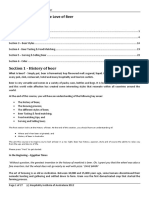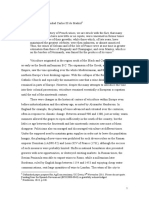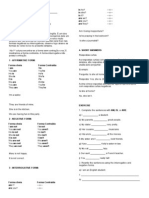Professional Documents
Culture Documents
Brewed Forcex
Brewed Forcex
Uploaded by
seniorudcOriginal Description:
Copyright
Available Formats
Share this document
Did you find this document useful?
Is this content inappropriate?
Report this DocumentCopyright:
Available Formats
Brewed Forcex
Brewed Forcex
Uploaded by
seniorudcCopyright:
Available Formats
Brewed force How a small, unremarkable country came to dominate the world of beermaking Dec 17th 2011 LEUVEN
AND WESTVLETEREN | THE Trappist Abbey of St Sixtus of Westvleteren has little to offer those wishing to gawp at ecclesiastical architecture. The 19th-century buildingssquat, brick and functionalsit on a quiet country lane amid flat farmland, close to Belgiums border with France. Yet the vast visitors car park is a clue that some people nevertheless consider the abbey worth a trip. For beer lovers, St Sixtus is a place of pilgrimage. The abbey and its most famous brew, Westvleteren 12a dark, strong alehave taken first or second place in an annual poll of beer enthusiasts favourite tipples by RateBeer.com, a widely trusted reviewing website, for the whole decade that the survey has been running. Yet exactly how the American drinkers who predominate on the site get to knock back a Westvleteren 12 is something of a mystery. Visit the abbeyno easy jaunt on public transportand you can drink it to your hearts content, or your heads. But it is hard to buy elsewhere. The monks tightly ration takeaway sales of the tiny quantities they produce. The abbeys website gives details of the brief windows when buyers may attempt to call with an order. If they are lucky and get through, they will be allotted a time to arrive at St Sixtus. They are then permitted to purchase two cases (four dozen 33cl bottles) in return for a solemn undertaking that the beer will not find its way to a third party. Evidently some people are prepared to lie to a monk for the sake of beer. Cases of Westvleteren 12, on sale at 39 ($53) at the abbey, turn up on online beer-sellers for as much as $800. (In a rare easing of the rules, in November the monks released a batch of 93,000 six-packs for the Belgian market, to pay for repairs to the abbey. Next year 70,000 six-packs will go on sale worldwide.) Pour reputation As well as having a good claim to brew the best beer in the world, Belgium is also home to the worlds biggest brewer. Anheuser-Busch (AB) InBev, based in Leuven, a small university town half an hour by train from Brussels, turns out one in five of every beer sold around the world. Across the road from head office, the ultramodern Stella Artois brewery pumps out one of the firms best-known international brands. If St Sixtus fails to match the splendour of a medieval cathedral, the main brewing hall at Stella Artois comes close. The quiet and cavernous interior is dominated by 15 immense stainless-steel brewing kettles, whose column-like spouts soar heavenwards. In different ways both St Sixtus and Stella Artois illustrate the reverence with which Belgians regard their beer. Their country also makes a bigger range than any other1,131 at the last count. Apart from six Trappist ales and other abbey beers, it churns out lagers such as Stella Artois and its stablemate Jupiler, the more popular brew in Belgium. Tipplers can also choose from an array of wheat beers, brown ales, red beers from West Flanders, golden ales, saison beers based on old farmhouse recipes, and any number of regional brews. Oddest are the austere, naturally fermented lambic beers of Brussels and the nearby Senne valley, a throwback to the days before yeast was tamed. These anachronisms have survived only in Belgium. Some people are prepared to lie to a monk for the sake of beer The country generously shares its creations with the rest of the world. It is one of the biggest exporters of beer in absolute terms and as a proportion of national production (statistics boosted by the worldwide thirst for Stella Artois). More than half the booze it makes is sent abroad.
How did a nation that, aside from its mussels and chips, renowned chocolate and reviled Eurocrats (the European Parliament is on the site of an old brewery), has made little impact on the world, come to dominate in beer? The answer lies in Belgiums hybrid history and culture. Beer is to Belgium as wine is to France. It is ingrained in the culture, says Marc Stroobandt, an expert on Belgian beer. Belgians have been at it for a long time: the Romans are said to have brought brewing to this part of Europe; many Belgian breweries have origins in the Middle Ages. Stella Artois traces its roots to the Den Hoorn brewery, founded in Leuven in 1366: the horn remains on the beers label to this day. Sebastian Artois brought his name to the brewery relatively latein 1717. Geography helped. A beer belt stretches across northern Europe, where it is too chilly to grow grapes that can be turned into half-decent wine. But the climate and the land are excellent for growing barley and hops, the basic ingredients of beer. Belgium is also known for its high-quality water, vital for turning out good beer. The town of Spa, whose name has become generic, is in eastern Belgium. As Sven Gatz, director of the Belgian Brewers Federation, points out, being at a crossroads of Latin and Germanic Europe allowed Belgium to soak up influences from both that can still be tasted in its beer. Herbs such as coriander and liquorice, spices such as ginger, and fruits such as cherries and raspberries, once popular among French brewers, are all still in use in Belgium. This French tradition endured where that countrys influence is strongest, even after hops began to find a role in beermaking. Monastic brewers were disinclined or prevented from using that ingredientthe church deemed hops the fruit of the devil. One explanation for this attitude might be the monopolies granted to bishops over the gruyt (as the mixture of herbs and spices was known) that went into beer. An intense medieval PR campaign was waged in the battle between gruyt and secular hops. Hildegard of Bingen, a medieval mystic, favoured gruyt, attacking hops for causing melancholy and the gentlemans affliction of brewers droop. Germanys influence is still discernible, too. The Reinheitsgebot, a Bavarian beer-purity law dating back to 1516, banned anything but water, barley and hops. Where the Germanic tendency is more pronounced, hops have always been preferred. Elsewhere, Belgian brewers continued to try their luck with whatever they could find. Almost a national religion Only here for the beer Thus the turbulence of the countrys history has stimulated its brewers. At one time or another most of Europes great powers have held sway over Belgium; many have left behind influences and flavours. The Dutch, the last outside power to occupy Belgium before the first world war, sent traders to scour the East Indies for new spices, many of which found their way into Belgian beer. (The Belgians kicked the Dutch out to gain independence in 1830 in part because they objected to heavy taxes on beer.) As the gruyt wars suggest, the institutions of Catholicism played a part, too. Monasteries traditionally brewed beer to sell to support their abbeys, to offer to travellers staying as guests and as liquid bread, a source of nourishment during Lent. Until the end of the 19th century, even when laymen ran breweries it was often educated monks who were at the forefront of the art and technology of beermaking. All these factors encouraged experimentation. Aside from herbs, spices and hops, other stranger substances such as mustard, coffee and chocolate have found their way into the countrys beer. Pete Brown, a British beer writer, is only half joking when he sees a common thread between the strange and mad brews that are the countrys hallmark and another of Belgiums relatively few gifts to the worldsurrealism. The number of breweries in Belgium peaked at the turn of the 20th century. By 1907 the country boasted nearly 3,400 commercial beermakers (compared with only around 100 today, or 12 per million peoplestill pretty generous compared with five per million in America). Belgians could and did enjoy a huge range of beers. These brewers had considerable advantages over their counterparts in other countries. In Britain beer was a drink of the lower orders: no such snobbishness obtained in Belgium. Heavy import duties discouraged Belgians from buying French wine. Competition from spirits was blunted by the temperance movement, explains Mr Brown. In Belgium it led to hefty duties on genever, a gin-like drink consumed by the Dutch, hitting its popularity. Brewers, some of whom were also politicians, managed to escape attack. Belgiums strong beers owe something to this period: many brewers upped the alcohol content to console drinkers forced to give up genever.
This lack of alternatives guaranteed brewers a large and thirsty market. In 1900 Belgians drank 200 litres per head, roughly double what Britons and Germans were putting away. Today thirsts have dried up a little: a typical Belgian now quaffs just 84 litres a year. The rise of AB InBev began in the halcyon years of the early 20th century. Before the first world war Belgian brewing was still highly fragmented. Start-up costs were low and transport expensive, so local, family-owned firms tended to predominate. Technological advance led to rapid consolidation. Belgian beers (strictly speaking, ales) were top fermented: the yeasty foam produced in the brewing process sat atop the liquid. But by the end of the 19th century a technique invented in Bavaria and developed in Bohemia arrived in Belgium. Lager, where the fermentation takes place at the bottom of the brewing vessel at a much lower temperature, required much more investment for artificial chilling and longer maturing times. But the clear, golden beer that resulted quickly caught on with consumers. One such was developed by Artois, by then Belgiums second-largest brewer. Its special Christmas brew of 1926 was decorated with a festive star: Stella Artois.
After dominating Belgian brewing for much of the century, at the end of it the firm embarked on an international consolidation before the worlds other main brewers caught on. Interbrew, as Belgiums biggest brewer was then known, bought Canadas Labatts in 1995 and merged with Brazils AmBev to forge the worlds largest outfit in 2004. The merged firm, InBev, snapped up AnheuserBusch, maker of Budweiser, in 2008. These days, as Americas microbrewing boom shows, discerning drinkers are keen to try new and unusual brews. Belgiums smaller breweries, with their niche beers, have benefited. Still golden On the Grand Place in Brussels stand the ornate guild houses of the citys ancient trades. The bakers and butchers houses are now restaurants. Another has become a bank. Yet the brewers house is still home to the Brewers Federation. The ceremony with which Belgian beer is poured and drunk betokens a love of beer that no other country can match. Arguments in a Belgian bar will not revolve around anything so trivial as politics or football. Fierce debate might centre on the correct glass in which to serve a Stella. In its hometown of Leuven it is a flat-sided tumbler; elsewhere only one with diamond mouldings near the base will do. A barman who neglects to inquire whether you prefer your bottle of Duvel shaken slightly to mix in the yeasty lees shouldnt expect a tip. Though its brewers have much to celebrate, Belgium as a whole is troubled. Among the most pressing problems is the bitter Wallonian-Flemish political divide that left the country without a permanent government for much for 2010 and 2011. A dissolution of the nation no longer looks impossible. Still, Belgians intending to drown their sorrows at least have an excellent variety of beers with which to do the job.
You might also like
- Beer in the Middle Ages and the RenaissanceFrom EverandBeer in the Middle Ages and the RenaissanceRating: 5 out of 5 stars5/5 (1)
- FarmhouseDocument4 pagesFarmhouseDrVollNo ratings yet
- Beer 101 - The Basics of BeerDocument19 pagesBeer 101 - The Basics of BeerJúlio Gabriel Queiroz dos SantosNo ratings yet
- Wine Industry PDFDocument16 pagesWine Industry PDFMainak BhowmikNo ratings yet
- Beer Knowledge Course Notes PDFDocument27 pagesBeer Knowledge Course Notes PDFSingh GursimranNo ratings yet
- Belgian Beer Experiences tcm24-7788 PDFDocument64 pagesBelgian Beer Experiences tcm24-7788 PDFAlejandro HercenbergNo ratings yet
- HandBook of BrewingDocument64 pagesHandBook of BrewingLuanPedroNo ratings yet
- Amber, Gold & Black: The History of Britain's Great BeersFrom EverandAmber, Gold & Black: The History of Britain's Great BeersRating: 5 out of 5 stars5/5 (1)
- Good Beer Guide Belgium 2014Document3 pagesGood Beer Guide Belgium 2014PaulNo ratings yet
- History of BeerDocument4 pagesHistory of BeerbekaluNo ratings yet
- All About German BeerDocument2 pagesAll About German Beerstelis2No ratings yet
- Beer InformationDocument23 pagesBeer InformationMinerva JuárezNo ratings yet
- Amber Ales (Ambrée and Speciale) : Beer in Belgium Varies From The PopularDocument10 pagesAmber Ales (Ambrée and Speciale) : Beer in Belgium Varies From The PopularFlorin CasotaNo ratings yet
- Where Now For German WineDocument14 pagesWhere Now For German WinepsykosomatikNo ratings yet
- British Food 6. PicturesDocument6 pagesBritish Food 6. PicturesEva SoosNo ratings yet
- Austria's Wine Producers: A selection from Lower Austria and the BurgenlandFrom EverandAustria's Wine Producers: A selection from Lower Austria and the BurgenlandNo ratings yet
- USSA Wine Course Book 2007 CCL Editon Jan 2007Document159 pagesUSSA Wine Course Book 2007 CCL Editon Jan 2007sarmis7100% (1)
- History Off BeerDocument3 pagesHistory Off BeerMario JammaersNo ratings yet
- The The Vineyards of Britain: Cellar Door Adventures with the Best of Britain's WinesFrom EverandThe The Vineyards of Britain: Cellar Door Adventures with the Best of Britain's WinesNo ratings yet
- Simpson Wine A Short HistoryDocument17 pagesSimpson Wine A Short HistoryKristine MontenegroNo ratings yet
- Belgian Beers: Where History Meets Globalization Damiaan Persyn, Johan F.M. Swinnen and Stijn VanormelingenDocument40 pagesBelgian Beers: Where History Meets Globalization Damiaan Persyn, Johan F.M. Swinnen and Stijn Vanormelingenshelly dineltonNo ratings yet
- Bar and Beverage Management Unit 1 NotesDocument12 pagesBar and Beverage Management Unit 1 NotesCjustin JudillaNo ratings yet
- English ProjectDocument4 pagesEnglish ProjectDaniel Trujillo ZapataNo ratings yet
- Gin Is A Distilled Alcoholic Drink That Derives Its PredominantDocument9 pagesGin Is A Distilled Alcoholic Drink That Derives Its PredominantNirmal BhowmickNo ratings yet
- Globalization of Brewing Industry and Brewing ProcessDocument20 pagesGlobalization of Brewing Industry and Brewing Processabhinav8803No ratings yet
- Best of Bordeaux: 200 legendary châteaux and their winesFrom EverandBest of Bordeaux: 200 legendary châteaux and their winesIntervinum AGNo ratings yet
- Malomo, OluDocument16 pagesMalomo, OluMfonNo ratings yet
- Beer Beer Beer Beer: Civilization and Beer Civilization and BeerDocument8 pagesBeer Beer Beer Beer: Civilization and Beer Civilization and Beerdaviddiablo9325219No ratings yet
- Beer Has Been Used Over The Centuries ToDocument38 pagesBeer Has Been Used Over The Centuries Torohit7853No ratings yet
- Full Ebook of Rick Steves Belgium Bruges Brussels Antwerp Ghent Rick Steves Gene Openshaw 2 Online PDF All ChapterDocument69 pagesFull Ebook of Rick Steves Belgium Bruges Brussels Antwerp Ghent Rick Steves Gene Openshaw 2 Online PDF All Chapteredithgoodwin860447100% (7)
- Porter Brew Has Long History in LatviaDocument3 pagesPorter Brew Has Long History in LatviaBradley SchultzNo ratings yet
- Brewery History: Brewing in Belgium and Belgian BeersDocument11 pagesBrewery History: Brewing in Belgium and Belgian BeersJ Elver SilvaNo ratings yet
- Drinking History: Fifteen Turning Points in The Making of American Beverages - Andrew F. SmithDocument20 pagesDrinking History: Fifteen Turning Points in The Making of American Beverages - Andrew F. SmithColumbia University PressNo ratings yet
- Belgian BeerDocument52 pagesBelgian BeerGary DonostiNo ratings yet
- The Oxford Companion To: Edited by Jancis RobinsonDocument4 pagesThe Oxford Companion To: Edited by Jancis RobinsonNabendu Saha0% (1)
- History of CafesDocument14 pagesHistory of CafesMujirulezNo ratings yet
- AppleDocument16 pagesAppledevashreeNo ratings yet
- Expensive Alcoholic BeverageDocument39 pagesExpensive Alcoholic BeverageChiranjivi SapkotaNo ratings yet
- City of BeerDocument60 pagesCity of BeernaokiyokoNo ratings yet
- Folleto - Prague BeerDocument35 pagesFolleto - Prague BeerFRANNo ratings yet
- Lonely Planet Lonely Planet's Global Beer TourFrom EverandLonely Planet Lonely Planet's Global Beer TourRating: 3.5 out of 5 stars3.5/5 (1)
- Vodka: Where It All BeganDocument8 pagesVodka: Where It All BeganiqbalNo ratings yet
- Alcoholic BeveragesDocument96 pagesAlcoholic BeveragesDesy RollistantiNo ratings yet
- The Beer Industry in The NetherlandsDocument2 pagesThe Beer Industry in The NetherlandsAliceLeNo ratings yet
- Beer by A.MolekDocument40 pagesBeer by A.Molekalexblood1741No ratings yet
- TextDocument15 pagesTextbarnovan.anaNo ratings yet
- Cork ScrewedDocument214 pagesCork ScrewedAnca Mircea100% (1)
- Ale For An Englishman Is A Natural DrinkDocument17 pagesAle For An Englishman Is A Natural Drinkpqi12023No ratings yet
- Loli Alonso - Manual Skills - European Workshop 2019-2020 - IDEMASAP 50+Document4 pagesLoli Alonso - Manual Skills - European Workshop 2019-2020 - IDEMASAP 50+seniorudcNo ratings yet
- Agenda - Idemasap Meeting in Portugal - 2019Document2 pagesAgenda - Idemasap Meeting in Portugal - 2019seniorudcNo ratings yet
- Guideline ProHospiz enDocument51 pagesGuideline ProHospiz enseniorudcNo ratings yet
- Presentación+MTN - Gante - 2012 CorregidoDocument61 pagesPresentación+MTN - Gante - 2012 CorregidoseniorudcNo ratings yet
- Final Product - Booklet of The MTN ProjectDocument52 pagesFinal Product - Booklet of The MTN ProjectseniorudcNo ratings yet
- Abstract, en Inglés, 13-4 - 2013, ListoDocument13 pagesAbstract, en Inglés, 13-4 - 2013, ListoseniorudcNo ratings yet
- Session 1 - March 8, 2013Document32 pagesSession 1 - March 8, 2013seniorudcNo ratings yet
- Reducido en Inglés. Power Point. SargadelosDocument14 pagesReducido en Inglés. Power Point. SargadelosseniorudcNo ratings yet
- Trabajo Cocina - Final (30 Pag)Document30 pagesTrabajo Cocina - Final (30 Pag)seniorudcNo ratings yet
- PRE Enrollment MTN 2012-20131Document1 pagePRE Enrollment MTN 2012-20131seniorudcNo ratings yet
- Our Continent Our Culture Hannover 2010Document16 pagesOur Continent Our Culture Hannover 2010seniorudcNo ratings yet
- Transition To Democracy in EuropeDocument63 pagesTransition To Democracy in EuropeseniorudcNo ratings yet
- Wassail MenuDocument2 pagesWassail MenuNell CaseyNo ratings yet
- Free Planner 2024 - MondayDocument120 pagesFree Planner 2024 - Mondaybellamauel1403No ratings yet
- Punjab Public Service Commission Punjab State Civil Services Combined Competitive Examination, 2012 - (Main)Document30 pagesPunjab Public Service Commission Punjab State Civil Services Combined Competitive Examination, 2012 - (Main)Myself NoorNo ratings yet
- Spontaneous Activity in Education by Montessori, Maria, 1870-1952Document164 pagesSpontaneous Activity in Education by Montessori, Maria, 1870-1952Gutenberg.org100% (5)
- The Clever FoxDocument2 pagesThe Clever FoxAngelica MorcozoNo ratings yet
- Biryani Center Final ReportDocument20 pagesBiryani Center Final ReportCozil AltafNo ratings yet
- Apostila To Be Verb e Simple PresentDocument3 pagesApostila To Be Verb e Simple PresentjamesmzsNo ratings yet
- Pumpkin Bread With Maple Syrup GlazeDocument4 pagesPumpkin Bread With Maple Syrup GlazeGeorgia GrantNo ratings yet
- Blue Nile State Situation Analysis March 2010Document56 pagesBlue Nile State Situation Analysis March 2010Sudan North-South Border Initiative50% (2)
- Jushua International CuisineDocument282 pagesJushua International CuisineOlsen SoqueñaNo ratings yet
- Gad Magna Carta For WomenDocument24 pagesGad Magna Carta For WomenCharline A. RadislaoNo ratings yet
- Eggplant: Health BenefitsDocument7 pagesEggplant: Health BenefitsShane Giacinth AmarilaNo ratings yet
- Pengaruh Metode Pengeringan Terhadap Karakter Mutu Fisik Dan Kimia Serbuk Minuman Instan Kulit Buah NagaDocument9 pagesPengaruh Metode Pengeringan Terhadap Karakter Mutu Fisik Dan Kimia Serbuk Minuman Instan Kulit Buah NagaHadi Yusuf FaturochmanNo ratings yet
- MN - 2020 03 24Document20 pagesMN - 2020 03 24moorabool100% (1)
- Cannon Fodder 2013Document3 pagesCannon Fodder 2013Christa E CannonNo ratings yet
- Communicative SituationsDocument16 pagesCommunicative SituationsGV Lê Thị Thuý Hà 24 THPT Sông LôNo ratings yet
- Hayat HotelsDocument39 pagesHayat HotelsSuhaniNo ratings yet
- Saul and David and The Law of The LidDocument7 pagesSaul and David and The Law of The LidjohncalebandalNo ratings yet
- Yield Potential of Different Certified Common Bean Varieties Under Different Tillage Methods in Kenya A Case of Laikipia CountyDocument6 pagesYield Potential of Different Certified Common Bean Varieties Under Different Tillage Methods in Kenya A Case of Laikipia CountyIJARP PublicationsNo ratings yet
- Dr. Steve Shirtliffe - Managing Weeds in Organic Pulse CropsDocument34 pagesDr. Steve Shirtliffe - Managing Weeds in Organic Pulse CropsOrganic AlbertaNo ratings yet
- Quizzes A-5Document14 pagesQuizzes A-5Juan NavarroNo ratings yet
- State-Of-The-Art Process Technology For: MaizeDocument8 pagesState-Of-The-Art Process Technology For: MaizeMaria Camila ArenasNo ratings yet
- Impact On The Zeolite Usage in Diary Cows Nutrition To Their Health Characteristics - Z. Ilić, S. Pešev, M. Milenković, B. MiloševićDocument9 pagesImpact On The Zeolite Usage in Diary Cows Nutrition To Their Health Characteristics - Z. Ilić, S. Pešev, M. Milenković, B. MiloševićCk_psihNo ratings yet
- Permuations Combinations PVDocument34 pagesPermuations Combinations PVPrepVelvetNo ratings yet
- Effects of Algal Bio-Fertilizer On The Growth Of: Vigna RadiataDocument5 pagesEffects of Algal Bio-Fertilizer On The Growth Of: Vigna RadiataerpublicationNo ratings yet
- THINK LEVEL 1 - Student's Book (Second Edition)Document131 pagesTHINK LEVEL 1 - Student's Book (Second Edition)Claudio Festenese100% (1)
- Food Safety and Standards (Packaging and Labelling) Regulation, 2011Document25 pagesFood Safety and Standards (Packaging and Labelling) Regulation, 2011aniketbilaye100% (1)
- Future Time Clauses: Present Simple / Present Continuous Refer To The FutureDocument2 pagesFuture Time Clauses: Present Simple / Present Continuous Refer To The FutureLinh ChuNo ratings yet
- Bakteri Asam LaktatDocument4 pagesBakteri Asam LaktatHastuti RahmasariiNo ratings yet
- Online Writing Course Request For Brochure: Practice Test 6Document17 pagesOnline Writing Course Request For Brochure: Practice Test 6Mai LêNo ratings yet





































































































